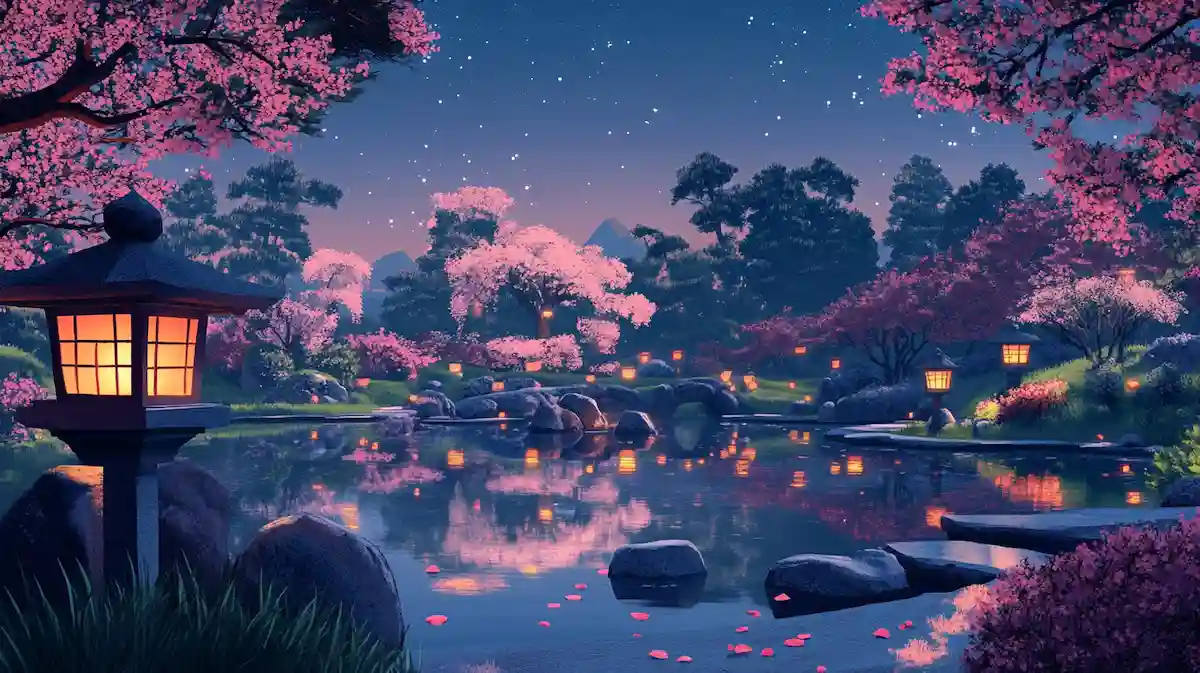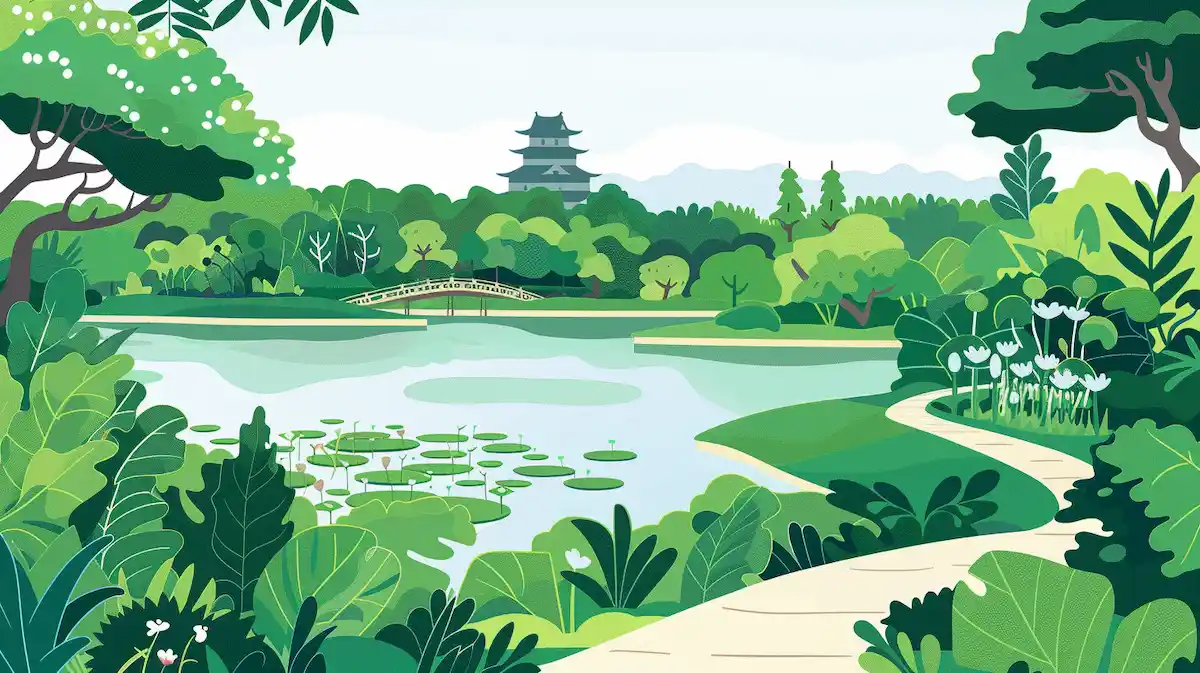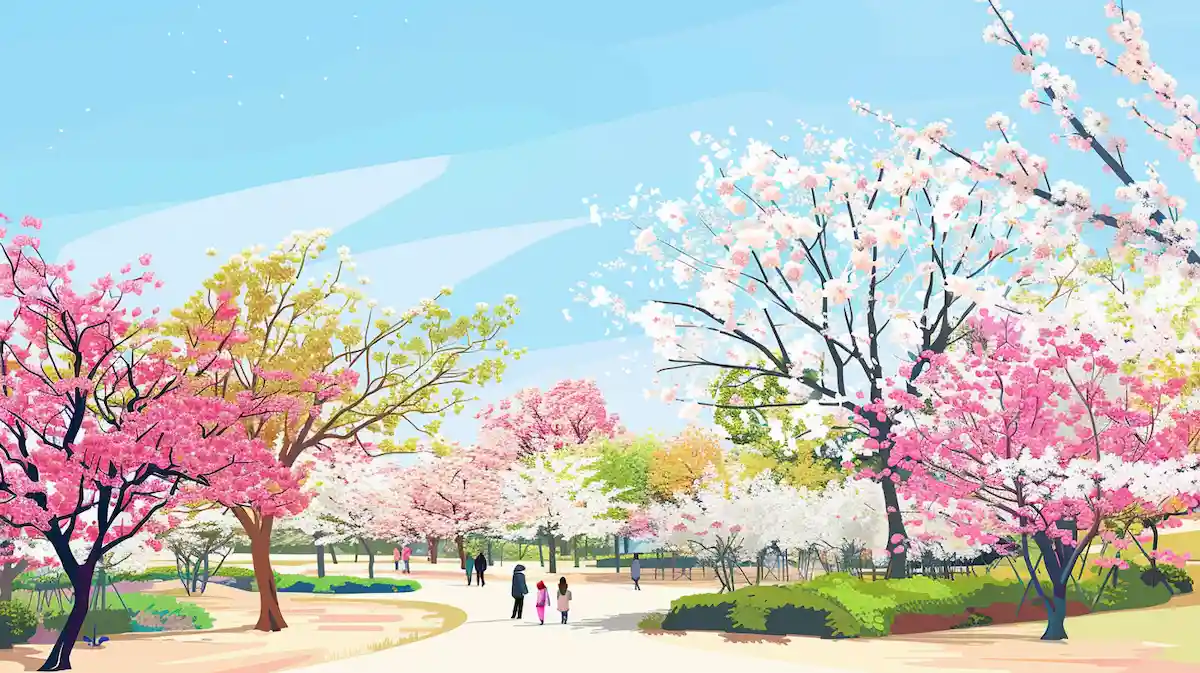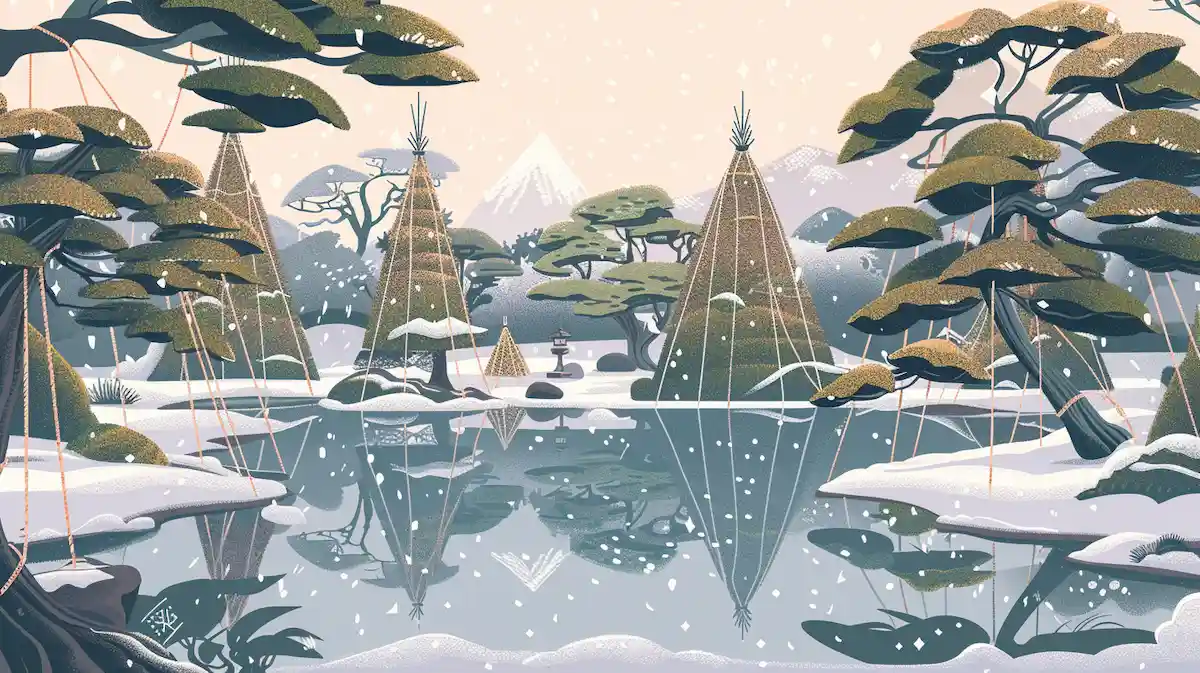兼六園を英語で説明・紹介するための基本情報と、英会話に役立つ表現をシンプルでわかりやすい英語で紹介します。
英会話ダイアローグ・概要・10の質問・詳細情報を通して、兼六園に関する英語表現を学びます。
英語
英会話ダイアローグを読む前に知っておくと良い前提知識と情報は以下の通りです。
- 兼六園の基本情報:
- 石川県金沢市にある日本三名園の一つ、兼六園、後楽園(岡山)、偕楽園(茨城)を指す
- 江戸時代に加賀藩の前田家によって作られた
- 名前の意味:
- 「兼六園」は「六つの優れた特質を持つ庭」という意味
- 広大さ、幽静さ、人工美、古雅、多水、眺望の六つの要素を表す
- 主要な見どころ:
- 庭園内には徽軫灯籠、霞ヶ池、日本最古の噴水、夕顔亭などの名所がある
- 季節の特徴:
- 春は桜、秋は紅葉、冬は雪吊りが見どころ
- 四季折々の美しさが楽しめる
- 雪吊り:
- 木の枝を縄で支え、雪の重みから守る
- 兼六園の冬の風物詩
2人が兼六園について話しています。
兼六園の歴史、名前の由来、庭園内の徽軫灯籠、霞ヶ池、日本最古の噴水、夕顔亭などの見どころ、冬の雪吊り、日本三名園の一つであることなどを話題にしています。
会話 / dialogue

Hey Key, I’ve been thinking about visiting Kenrokuen. I’ve heard it’s one of the most beautiful gardens in Japan.

Yes, Kenrokuen is stunning! It’s one of the Three Great Gardens of Japan, along with Kairakuen and Korakuen. Do you know much about its history?

Not much, actually. Just that it’s in Kanazawa. What’s the story behind it?

It was created in the 17th century by the Maeda family, who were the lords of the Kaga Domain. The garden has a long history and was designed to showcase six ideal qualities: spaciousness, seclusion, artificiality, antiquity, water sources, and scenic views.

That’s interesting! And the name “Kenrokuen,” does it have a special meaning?

Yes, the name means “Garden of the Six Sublimities.” It reflects those six ideal qualities I mentioned. The garden was named by Matsudaira Sadanobu, who was inspired by a Chinese classic.

I see. What are some of the must-see spots in Kenrokuen?

Definitely the Kotojitoro Lantern, which is an iconic stone lantern with two legs. There’s also Kasumigaike Pond, which has beautiful reflections of the scenery. Don’t miss the oldest fountain in Japan, which works without pumps, using natural water pressure.

Sounds beautiful. I’m also curious about visiting in winter. I’ve heard about something called yukitsuri. What’s that?

Yukitsuri is a traditional technique used in Kenrokuen to protect the trees from heavy snow. Ropes are tied to the branches and lifted up to prevent them from breaking under the snow’s weight. It’s a unique feature of the garden, especially in winter, creating a picturesque scene.

That sounds like a magical winter scene. When is the best time to visit?

Spring and autumn are the most popular because of the cherry blossoms and the autumn foliage. But winter with the yukitsuri is also special, and summer offers lush greenery. Each season has its own charm.

I think I’ll try to visit during spring for the cherry blossoms. They must be amazing there.

Absolutely, the cherry blossoms are breathtaking. And there’s also a tea house called Yugao-tei where you can experience a traditional tea ceremony. It’s the oldest building in the garden.

That sounds perfect. I’m really looking forward to exploring Kenrokuen. Thanks for all the information, Key!

No problem, Mack. I’m sure you’ll love it. It’s a great place to experience traditional Japanese garden design and natural beauty.

I can’t wait to see it all for myself. I’ll definitely take lots of pictures!

You should! Kenrokuen is one of those places that looks amazing in photos and even better in person. Enjoy your visit!
概要 / Overview
「兼六園」について、理解を深めるための「英語での概要」です。
兼六園

Basic Information
Kenrokuen is a famous garden located in Kanazawa City, Ishikawa Prefecture, Japan. It is one of the Three Great Gardens of Japan, along with Kairakuen and Korakuen. The garden was created by the Maeda family during the Edo period and has a rich history.
Name Meaning
The name “Kenrokuen” means “Garden of the Six Sublimities.” It represents the six ideal qualities of a garden: spaciousness, seclusion, artificiality, antiquity, water sources, and scenic views. These qualities make Kenrokuen a perfect example of a traditional Japanese garden.
Main Attractions
Kenrokuen has many beautiful spots. The Kotojitoro Lantern is an iconic stone lantern with two legs. Kasumigaike Pond offers lovely reflections of the surrounding scenery. The garden also has the oldest fountain in Japan, which works using natural water pressure. Another highlight is the Yugao-tei tea house, where visitors can experience a traditional Japanese tea ceremony.
Seasonal Features
Kenrokuen is beautiful in every season. In spring, cherry blossoms bloom, making the garden colorful. In autumn, the leaves turn vibrant red and orange. Winter is special because of the yukitsuri, a traditional technique used to protect trees from heavy snow. This makes Kenrokuen a great place to visit all year round.
10の質問 / 10 questions
「兼六園」について、理解を深めるための「英語での10の質問」です。
1: What is Kenrokuen?
Kenrokuen is a famous traditional Japanese garden located in Kanazawa, Ishikawa Prefecture. It is known as one of the Three Great Gardens of Japan.
2: Who created Kenrokuen?
Kenrokuen was created by the Maeda family, who were the feudal lords of the Kaga Domain, during the Edo period.
3: What does the name "Kenrokuen" mean?
The name "Kenrokuen" means "Garden of the Six Sublimities," referring to the six ideal qualities of a garden: spaciousness, seclusion, artificiality, antiquity, water sources, and scenic views.
4: What are some of the main attractions in Kenrokuen?
Some main attractions in Kenrokuen include the Kotojitoro Lantern, Kasumigaike Pond, the oldest fountain in Japan, and the Yugao-tei tea house.
5: What is special about the Kotojitoro Lantern?
The Kotojitoro Lantern is an iconic stone lantern with two legs, making it one of the most recognizable features of Kenrokuen.
6: What is yukitsuri?
Yukitsuri is a traditional technique used in winter to protect trees from heavy snow. Ropes are tied in a conical shape around the trees to support the branches.
7: When is the best time to visit Kenrokuen?
The best times to visit Kenrokuen are in spring for cherry blossoms and in autumn for the colorful leaves. However, winter with the yukitsuri is also very beautiful.
8: What can visitors experience at the Yugao-tei tea house?
Visitors can experience a traditional Japanese tea ceremony at the Yugao-tei tea house, which is the oldest building in Kenrokuen.
9: How is the garden maintained during winter?
During winter, Kenrokuen uses the yukitsuri technique to protect the trees from snow, and the garden is carefully maintained to preserve its beauty.
10: Why is Kenrokuen important in Japanese culture?
Kenrokuen is important because it represents the height of Japanese garden design and reflects the cultural and historical values of the Edo period. It is also a popular tourist destination that showcases traditional Japanese aesthetics.
和訳付
会話 / dialogue

Hey Key, I’ve been thinking about visiting Kenrokuen.
キー、兼六園に行ってみようと思っているんだ。

Yes, Kenrokuen is stunning! It’s one of the Three Great Gardens of Japan, along with Kairakuen and Korakuen. Do you know much about its history?
そうだね、兼六園は素晴らしいよ!偕楽園と後楽園と並んで日本三名園の一つなんだ。歴史については知ってる?

Not much, actually. Just that it’s in Kanazawa. What’s the story behind it?
実はあまり知らないんだ。金沢にあることくらいしか。どんな話があるの?

It was created in the 17th century by the Maeda family, who were the lords of the Kaga Domain. The garden has a long history and was designed to showcase six ideal qualities: spaciousness, seclusion, artificiality, antiquity, water sources, and scenic views.
17世紀に加賀藩主の前田家によって作られたんだ。長い歴史があって、「広大さ」「幽静」「人工美」「古雅」「多水」「眺望」の六つの理想的な要素を兼ね備えるように設計されたんだよ。

That’s interesting! And the name “Kenrokuen,” does it have a special meaning?
面白いね!「兼六園」って名前には特別な意味があるの?

Yes, the name means “Garden of the Six Sublimities.” It reflects those six ideal qualities I mentioned. The garden was named by Matsudaira Sadanobu, who was inspired by a Chinese classic.
そうだよ、「六つの優れた特質を持つ庭」という意味なんだ。その六つの理想的な要素を表しているんだよ。この名前は松平定信が中国の古典にちなんで名付けたんだ。

I see. What are some of the must-see spots in Kenrokuen?
なるほどね。兼六園で必見のスポットってどこかな?

Definitely the Kotojitoro Lantern, which is an iconic stone lantern with two legs. There’s also Kasumigaike Pond, which has beautiful reflections of the scenery. Don’t miss the oldest fountain in Japan, which works without pumps, using natural water pressure.
間違いなく徽軫灯籠だね、二本足の象徴的な石灯籠だよ。あとは霞ヶ池も綺麗で、風景が美しく映り込むんだ。それから、日本最古の噴水も見逃せないよ。ポンプなしで自然の水圧で動くんだ。

Sounds beautiful. I’m also curious about visiting in winter. I’ve heard about something called yukitsuri. What’s that?
美しそうだね。冬に訪れるのも気になるな。雪吊りって聞いたことがあるけど、それって何?

Yukitsuri is a traditional technique used in Kenrokuen to protect the trees from heavy snow. Ropes are tied to the branches and lifted up to prevent them from breaking under the snow’s weight. It’s a unique feature of the garden, especially in winter, creating a picturesque scene.
雪吊りは兼六園で木々を重い雪から守るための伝統的な技法だよ。枝にロープを結びつけて上に引っ張り、雪の重さで折れないようにするんだ。特に冬にはこの景観が独特で、絵のような風景を作り出すんだよ。

That sounds like a magical winter scene. When is the best time to visit?
それは魔法のような冬の景色だね。訪れるのに最適な時期はいつ?

Spring and autumn are the most popular because of the cherry blossoms and the autumn foliage. But winter with the yukitsuri is also special, and summer offers lush greenery. Each season has its own charm.
桜の春と紅葉の秋が最も人気があるよ。でも雪吊りのある冬も特別だし、夏は緑が豊かで素晴らしいよ。どの季節もそれぞれの魅力があるんだ。

I think I’ll try to visit during spring for the cherry blossoms. They must be amazing there.
春の桜の時期に行ってみようかな。そこはきっと素晴らしいだろうね。

Absolutely, the cherry blossoms are breathtaking. And there’s also a tea house called Yugao-tei where you can experience a traditional tea ceremony. It’s the oldest building in the garden.
間違いないよ、桜は本当に美しいんだ。それに夕顔亭という茶室もあって、そこで伝統的な茶道を体験できるよ。庭園内で最も古い建物なんだ。

That sounds perfect. I’m really looking forward to exploring Kenrokuen. Thanks for all the information, Key!
完璧だね。兼六園を探検するのが本当に楽しみだよ。情報ありがとう、キー!

No problem, Mack. I’m sure you’ll love it. It’s a great place to experience traditional Japanese garden design and natural beauty.
どういたしまして、マック。きっと気に入ると思うよ。伝統的な日本庭園のデザインと自然の美しさを体験できる素晴らしい場所だからね。

I can’t wait to see it all for myself. I’ll definitely take lots of pictures!
自分の目で全部見るのが待ちきれないよ。たくさん写真を撮るつもりだ!

You should! Kenrokuen is one of those places that looks amazing in photos and even better in person. Enjoy your visit!
そうだね!兼六園は写真でも素晴らしいけど、実際に見るともっと感動するよ。訪問を楽しんでね!
概要 / Overview
兼六園

Basic Information
Kenrokuen is a famous garden located in Kanazawa City, Ishikawa Prefecture, Japan. It is one of the Three Great Gardens of Japan, along with Kairakuen and Korakuen. The garden was created by the Maeda family during the Edo period and has a rich history.
兼六園は、日本の石川県金沢市にある有名な庭園です。偕楽園、後楽園と並んで日本三名園の一つです。江戸時代に前田家によって作られたこの庭園は、豊かな歴史を持っています。
Name Meaning
The name “Kenrokuen” means “Garden of the Six Sublimities.” It represents the six ideal qualities of a garden: spaciousness, seclusion, artificiality, antiquity, water sources, and scenic views. These qualities make Kenrokuen a perfect example of a traditional Japanese garden.
「兼六園」という名前は「六つの優れた特質を持つ庭」という意味です。これは、広大さ、幽静さ、人工美、古雅、多水、眺望という、理想的な庭園の六つの特質を表しています。これらの特質が兼六園を伝統的な日本庭園の完璧な例にしています。
Main Attractions
Kenrokuen has many beautiful spots. The Kotojitoro Lantern is an iconic stone lantern with two legs. Kasumigaike Pond offers lovely reflections of the surrounding scenery. The garden also has the oldest fountain in Japan, which works using natural water pressure. Another highlight is the Yugao-tei tea house, where visitors can experience a traditional Japanese tea ceremony.
兼六園には多くの美しい場所があります。徽軫灯籠は二本足の象徴的な石灯籠です。霞ヶ池では周囲の風景が美しく映り込みます。また、自然の水圧を利用して動く日本最古の噴水もあります。さらに、夕顔亭という茶室では、伝統的な日本の茶道を体験することができます。
Seasonal Features
Kenrokuen is beautiful in every season. In spring, cherry blossoms bloom, making the garden colorful. In autumn, the leaves turn vibrant red and orange. Winter is special because of the yukitsuri, a traditional technique used to protect trees from heavy snow. This makes Kenrokuen a great place to visit all year round.
兼六園は四季を通じて美しい庭園です。春には桜が咲き、庭園が色鮮やかになります。秋には葉が鮮やかな赤やオレンジに変わります。冬は特別で、重い雪から木々を守るための伝統的な技法である雪吊りが見られます。これにより、兼六園は一年中訪れる価値のある場所となっています。
10の質問 / 10 questions
1: What is Kenrokuen?
兼六園とは何ですか?
Kenrokuen is a famous traditional Japanese garden located in Kanazawa, Ishikawa Prefecture. It is known as one of the Three Great Gardens of Japan.
兼六園は、石川県金沢市にある有名な日本の伝統的な庭園です。日本三名園の一つとして知られています。
2: Who created Kenrokuen?
兼六園は誰が作ったのですか?
Kenrokuen was created by the Maeda family, who were the feudal lords of the Kaga Domain, during the Edo period.
兼六園は、江戸時代に加賀藩の藩主であった前田家によって作られました。
3: What does the name "Kenrokuen" mean?
「兼六園」という名前の意味は何ですか?
The name "Kenrokuen" means "Garden of the Six Sublimities," referring to the six ideal qualities of a garden: spaciousness, seclusion, artificiality, antiquity, water sources, and scenic views.
「兼六園」という名前は「六つの優れた特質を持つ庭」という意味で、広大さ、幽静さ、人工美、古雅、多水、眺望という理想的な庭園の特質を表しています。
4: What are some of the main attractions in Kenrokuen?
兼六園の主な見どころは何ですか?
Some main attractions in Kenrokuen include the Kotojitoro Lantern, Kasumigaike Pond, the oldest fountain in Japan, and the Yugao-tei tea house.
兼六園の主な見どころには、徽軫灯籠、霞ヶ池、日本最古の噴水、そして夕顔亭の茶室があります。
5: What is special about the Kotojitoro Lantern?
徽軫灯籠の特別なところは何ですか?
The Kotojitoro Lantern is an iconic stone lantern with two legs, making it one of the most recognizable features of Kenrokuen.
徽軫灯籠は二本足の象徴的な石灯籠で、兼六園の最も特徴的な要素の一つです。
6: What is yukitsuri?
雪吊りとは何ですか?
Yukitsuri is a traditional technique used in winter to protect trees from heavy snow. Ropes are tied in a conical shape around the trees to support the branches.
雪吊りは、冬に木々を重い雪から守るための伝統的な技法です。枝を支えるために、木に円錐形にロープが結ばれます。
7: When is the best time to visit Kenrokuen?
兼六園を訪れるのに最適な時期はいつですか?
The best times to visit Kenrokuen are in spring for cherry blossoms and in autumn for the colorful leaves. However, winter with the yukitsuri is also very beautiful.
兼六園を訪れるのに最適な時期は、桜の春と紅葉の秋です。ただし、雪吊りのある冬も非常に美しいです。
8: What can visitors experience at the Yugao-tei tea house?
夕顔亭の茶室では、訪問者は何を体験できますか?
Visitors can experience a traditional Japanese tea ceremony at the Yugao-tei tea house, which is the oldest building in Kenrokuen.
訪問者は、兼六園で最も古い建物である夕顔亭の茶室で、伝統的な日本の茶道を体験できます。
9: How is the garden maintained during winter?
冬の間、庭園はどのように管理されていますか?
During winter, Kenrokuen uses the yukitsuri technique to protect the trees from snow, and the garden is carefully maintained to preserve its beauty.
冬の間、兼六園では雪吊り技法を使用して木々を雪から守り、庭園の美しさを保つために丁寧に管理されています。
10: Why is Kenrokuen important in Japanese culture?
兼六園は日本文化においてなぜ重要ですか?
Kenrokuen is important because it represents the height of Japanese garden design and reflects the cultural and historical values of the Edo period. It is also a popular tourist destination that showcases traditional Japanese aesthetics.
兼六園は、日本庭園デザインの最高峰を代表し、江戸時代の文化的および歴史的価値を反映しているため重要です。また、伝統的な日本の美学を示す人気の観光地でもあります。
words & phrases
英会話ダイアローグと関連情報に出てきた単語・フレーズです(例文は各3つ)。

stunning : 形容詞
意味: 驚くほど美しい、見事な。Extremely impressive or attractive.
(兼六園の桜や紅葉などの美しい景色を表現するために使用)
例文:
- The garden’s cherry blossoms were absolutely stunning.
「庭園の桜は本当に見事でした。」 - She wore a stunning dress to the party.
「彼女はパーティーに見事なドレスを着てきました。」 - The sunset over the mountains was stunning.
「山々に沈む夕日は見事でした。」
reflection : 名詞
意味: 反射、映像、考え。The return of light or sound waves from a surface; an image seen in a mirror or shiny surface; a thought or opinion.
(霞ヶ池に映り込む風景を指す)
例文:
- The reflection of the trees in the pond was beautiful.
「池に映る木々の映像が美しかった。」 - She spent some time in reflection before making a decision.
「彼女は決断を下す前に考えを巡らせました。」 - The glass showed a clear reflection of the room.
「ガラスには部屋のはっきりした映像が映っていました。」
seclusion : 名詞
意味: 隠遁、隔離。The state of being private and away from other people.
(兼六園が提供する静けさや孤立した環境を表す)
例文:
- The garden offers a sense of seclusion from the busy city.
「この庭園は忙しい街からの静寂を提供します。」 - He enjoys the seclusion of his cabin in the woods.
「彼は森の中の小屋での隠遁生活を楽しんでいます。」 - The writer found inspiration in the seclusion of the mountains.
「作家は山の中の静かな場所でインスピレーションを見つけました。」
fountain : 名詞
意味: 噴水、水の泉。A structure that sends water up into the air, often as a decoration.
(兼六園の日本最古の噴水を指す)
例文:
- The fountain in the garden is the oldest in Japan.
「その庭園の噴水は日本最古のものです。」 - They threw coins into the fountain for good luck.
「彼らは幸運を祈って噴水にコインを投げ入れました。」 - The children played near the water fountain in the park.
「子供たちは公園の噴水の近くで遊びました。」
picturesque : 形容詞
意味: 絵のように美しい、風光明媚な。Visually attractive, especially in a quaint or charming way.
(兼六園の雪吊りや四季折々の風景を形容するために使用)
例文:
- The coastline is known for its picturesque scenery.
「その海岸線は美しい風景で知られています。」 - The snow-covered garden was truly picturesque.
「雪に覆われた庭園は本当に絵のように美しかった。」 - The small village looked picturesque against the mountain backdrop.
「その小さな村は山を背景にして絵のように美しかった。」
詳細情報 / Further Info
兼六園の歴史

Origins of Kenrokuen
Kenrokuen is one of the Three Great Gardens of Japan, located in Kanazawa, Ishikawa Prefecture. It was created in the 17th century by the Maeda family, the feudal lords of the Kaga Domain. At first, it was called “Renchi-tei” and was a private garden for the Maeda clan.
兼六園の起源
兼六園は、日本三名園の一つで、石川県金沢市に位置しています。17世紀に加賀藩の藩主であった前田家によって作られました。最初は「蓮池庭」と呼ばれ、前田家の私的な庭園として利用されていました。
Renaming to Kenrokuen
In 1759, a large fire damaged part of the garden. Later, in 1788, the 11th feudal lord Maeda Harunaga rebuilt the garden and named it “Kenrokuen.” The name means “Garden of the Six Sublimities,” symbolizing spaciousness, seclusion, artificiality, antiquity, water sources, and scenic views.
兼六園への改名
1759年、大火により庭園の一部が焼失しました。その後、1788年に11代藩主の前田治脩が庭園を再建し、「兼六園」と命名しました。この名前は「広大さ」「幽静」「人工美」「古雅」「多水」「眺望」という六つの理想的な特質を象徴しています。
Opening to the Public
After the Meiji Restoration, the garden was opened to the public in 1874. It became a popular place for visitors to enjoy its beauty throughout the seasons. In 1953, Kenrokuen was designated as a Special Place of Scenic Beauty, preserving it as an important cultural and historical site.
一般公開と現在
明治維新後、庭園は1874年に一般公開されました。四季折々の美しさを楽しむため、多くの訪問者に親しまれる場所となりました。1953年には特別名勝に指定され、日本の文化と歴史を象徴する重要な場所として保護されています。
兼六園の見どころ(徽軫灯籠、霞ヶ池、虎石)

Kotojitoro Lantern
The Kotojitoro Lantern is one of the most iconic features of Kenrokuen. It is a stone lantern with two legs, standing near Kasumigaike Pond. Its unique design symbolizes a koto, a traditional Japanese harp, as its name suggests. The lantern creates a picturesque view when reflected in the pond, making it a popular spot for photos.
徽軫灯籠
徽軫灯籠は、兼六園を象徴する最も有名な特徴の一つです。二本足の石灯籠で、霞ヶ池のそばに立っています。そのユニークなデザインは、名前の通り日本の伝統的な楽器「琴」を象徴しています。池に映り込む姿は絵のように美しく、写真撮影スポットとして人気です。
Kasumigaike Pond
Kasumigaike Pond is the centerpiece of Kenrokuen. It features a small island and stone bridges, enhancing the garden’s beauty. The pond reflects the trees, lanterns, and surrounding scenery, creating a tranquil and scenic atmosphere. Each season brings a unique charm, from cherry blossoms in spring to snow-covered landscapes in winter.
霞ヶ池
霞ヶ池は兼六園の中心的な存在です。小さな島や石橋があり、庭園の美しさを引き立てています。池は木々や灯籠、周囲の景色を映し出し、静かで美しい雰囲気を作り出します。春の桜から冬の雪景色まで、四季折々の魅力を楽しめます。
Toraishi Rock
Toraishi, or “Tiger Rock,” is located in Kasumigaike Pond. The patterns on the rock resemble tiger stripes, making it an interesting feature of the garden. It is carefully placed to blend with the natural and artificial elements of the landscape, showcasing the garden’s design harmony.
虎石
虎石は、霞ヶ池にある「虎模様」のような模様を持つ岩です。庭園の自然と人工の要素が調和したデザインの一例として注目されています。
兼六園の見どころ(唐崎松、夕顔亭、日本最古の噴水)

Karasaki Pine
The Karasaki Pine is a famous pine tree brought from Karasaki near Lake Biwa. Its long, spreading branches are protected in winter by a traditional snow-protection method called yukitsuri. This tree is a symbol of the garden’s beauty during winter.
唐崎松
唐崎松は、琵琶湖近くの唐崎から運ばれた有名な松の木です。その長く広がる枝は、冬には雪吊りという伝統的な方法で保護されます。この木は、冬の兼六園の美しさを象徴しています。
Yugao-tei Tea House
Yugao-tei is the oldest building in Kenrokuen. It is a traditional tea house where visitors can experience Japanese tea culture. Surrounded by trees, it provides a quiet and peaceful atmosphere.
夕顔亭
夕顔亭は、兼六園で最も古い建物です。伝統的な茶室で、日本の茶文化を体験できます。木々に囲まれた静かな雰囲気が特徴です。
Japan’s Oldest Fountain
Kenrokuen is home to Japan’s oldest fountain, which works using natural water pressure from Kasumigaike Pond. It is a symbol of Edo-period engineering and still fascinates visitors today.
日本最古の噴水
兼六園には日本最古の噴水があります。この噴水は、霞ヶ池の自然水圧を利用して動作しています。江戸時代の技術力を象徴しており、現在でも訪問者を驚かせています。
雪吊り

What is Yukitsuri?
Yukitsuri is a traditional Japanese technique used to protect trees from heavy snow. Ropes are tied from a central pole to the branches, creating a cone-like shape. This prevents the branches from breaking under the weight of snow. It is most commonly used on pine trees but is also applied to other trees in Japanese gardens.
雪吊りとは?
雪吊りは、重い雪から木々を守るために使われる日本の伝統的な技法です。中央の柱から枝に向かってロープを結び、円錐形の形状を作ります。これにより、雪の重みで枝が折れるのを防ぎます。主に松の木に施されますが、日本庭園の他の木々にも使用されます。
Purpose of Yukitsuri
The main purpose of yukitsuri is to protect trees from damage during snowy winters. However, it also has an aesthetic purpose. The cone-shaped structure adds beauty to Japanese gardens, especially when covered in snow. Yukitsuri represents the balance between functionality and artistry in traditional Japanese gardening.
雪吊りの目的
雪吊りの主な目的は、雪の多い冬に木々が損傷するのを防ぐことです。しかし、美観の面でも重要な役割を果たします。雪に覆われた円錐形の構造は、日本庭園に美しさを加えます。雪吊りは、伝統的な日本庭園における機能性と芸術性の調和を象徴しています。
Yukitsuri in Kenrokuen
In Kenrokuen, yukitsuri is performed every year between November and December to prepare for winter. Skilled gardeners carefully tie the ropes to protect the trees. One of the most famous examples is the Karasaki Pine, which looks stunning with its snow-covered ropes. Yukitsuri is a symbol of Kenrokuen’s winter scenery.
兼六園での雪吊り
兼六園では、毎年11月から12月にかけて雪吊りが行われ、冬に備えます。熟練した庭師たちが丁寧にロープを結び、木々を保護します。最も有名な例の一つが唐崎松で、雪に覆われたロープとともに美しい姿を見せます。雪吊りは、兼六園の冬の風物詩です。
The Beauty of Yukitsuri
Yukitsuri creates a unique and peaceful winter landscape. The sight of snow-covered trees with ropes arranged in perfect symmetry is a favorite for visitors and photographers. It is not just a practical technique but also a cultural tradition that showcases the beauty of Japanese gardens.
雪吊りの美しさ
雪吊りは、独特で静かな冬の風景を作り出します。雪に覆われ、ロープが対称的に配置された木々の景色は、訪問者や写真家にとってお気に入りのテーマです。雪吊りは単なる実用技術ではなく、日本庭園の美しさを示す文化的な伝統でもあります。
日本三名園

What are the Three Great Gardens of Japan?
The Three Great Gardens of Japan are Kenrokuen in Kanazawa, Korakuen in Okayama, and Kairakuen in Mito. These gardens are considered the most beautiful in Japan and represent different styles of traditional Japanese garden design. Each garden has unique features that reflect its local history and culture.
日本三名園とは?
日本三名園は、金沢の兼六園、岡山の後楽園、水戸の偕楽園を指します。これらの庭園は、日本で最も美しい庭園とされており、伝統的な日本庭園の異なる様式を表現しています。それぞれの庭園は、地域の歴史や文化を反映した独自の特徴を持っています。
Kenrokuen in Kanazawa
Kenrokuen is located in Kanazawa, Ishikawa Prefecture. It was created by the Maeda family during the Edo period and is famous for its seasonal beauty. The garden’s name means “Garden of the Six Sublimities,” referring to spaciousness, seclusion, artificiality, antiquity, water sources, and scenic views. Iconic features include the Kotojitoro Lantern, Kasumigaike Pond, and the traditional yukitsuri in winter.
金沢の兼六園
兼六園は石川県金沢市にあります。江戸時代に前田家によって作られ、四季折々の美しさで有名です。庭園の名前は「広大さ」「幽静」「人工美」「古雅」「多水」「眺望」という六つの理想を意味しています。徽軫灯籠や霞ヶ池、冬の雪吊りが象徴的な特徴です。
Korakuen in Okayama
Korakuen is in Okayama, Okayama Prefecture. It was built by the Ikeda family during the Edo period. The garden follows a circular layout with a large central pond and walking paths. Visitors can enjoy views of Okayama Castle from the garden. It is also known for its wide open spaces and traditional noh stage.
岡山の後楽園
後楽園は岡山県岡山市にあります。江戸時代に池田家によって作られました。大きな池を中心とした回遊式庭園で、園内の道を歩きながら景色を楽しむことができます。庭園から岡山城を望むことができ、広々とした空間や伝統的な能舞台でも知られています。
Kairakuen in Mito
Kairakuen is located in Mito, Ibaraki Prefecture. It was created by Tokugawa Nariaki during the Edo period and was designed for both feudal lords and ordinary people. The garden is famous for its plum blossoms, with over 100 varieties and 3,000 trees. Visitors can also enjoy views of the garden from the historic Kobuntei building.
水戸の偕楽園
偕楽園は茨城県水戸市にあります。江戸時代に徳川斉昭によって作られ、大名だけでなく一般市民も楽しめる庭園として設計されました。約100種類、3000本の梅の木が植えられており、梅の名所として有名です。また、歴史的な建物「好文亭」から庭園全体を見渡すことができます。
Similarities and Differences
All three gardens were created during the Edo period and reflect the values of traditional Japanese garden design. However, each has its own unique charm. Kenrokuen is famous for its seasonal beauty, Korakuen for its open spaces and walking paths, and Kairakuen for its plum blossoms and accessibility to the public.
共通点と違い
これらの庭園はすべて江戸時代に作られ、伝統的な日本庭園の価値観を反映しています。ただし、それぞれ独自の魅力を持っています。兼六園は四季の美しさで知られ、後楽園は広々とした空間と回遊式の設計が特徴で、偕楽園は梅の花と市民に開かれた設計が魅力です。
関連記事(日本庭園、後楽園、偕楽園)



